Public Meeting – 10th & Monroe Development -Update
The proposed development at 10th Street and Monroe has generated significant concern from the community. This article provides an overview of the proposal, the public input process published by the developer and Atlanta BeltLine Inc. (ABI), and key issues related to the proposed development. The Virginia-Highland Civic Association (VHCA) will be hosting a public meeting at 7:00PM on Thursday, April 19th at The Virginia-Highland Church (743 Virginia Avenue) regarding this proposed development and next steps.
I. OVERVIEW OF DEVELOPMENT AND PROCESS
The area for the proposed development is the southwest block at Monroe and Cresthill (see map below). Jim Kegley, a partner in 10th and Monroe, LLC, is part of a joint venture that owns the commercial properties marked C1 below and all single family homes marked R4 below other than 565 Cresthill.
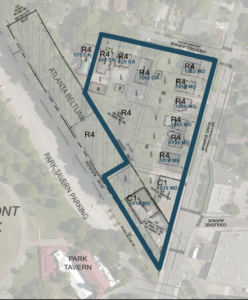
Aerial sketch of proposed project area
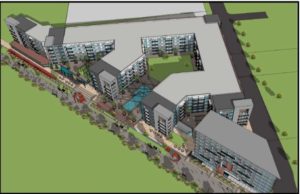
Concept from proposal to Invest Atlanta
Jim Kegley, as part of 10th and Monroe, LLC has partnered with Fuqua Development to develop this area. They submitted a bid to purchase a small section of BeltLine land adjacent to their commercial properties and single family homes (marked “Atlanta BeltLine” above). The fact sheet on their bid to purchase the BeltLine land and develop this area can be found at the following link: Invest Atlanta – Fact Sheet
Invest Atlanta (IA), the City of Atlanta’s Development Authority, voted to enter into a Memorandum of Understanding (MOU) for the purchase of the BeltLine land with Kegley/Fuqua at the December 19, 2017 IA meeting. Little notice was provided about the IA vote, and the actual vote was conducted in Executive Session and not open to the public. Although VHCA only received 48 hours’ notice of the impending vote, several VHCA Board and Planning Committee members, as well as NPU officers, attended the Invest Atlanta meeting to object to the vote and the proposed development. VHCA also submitted a letter objecting to the Invest Atlanta vote and proposed development (see VHCA article and letter to Invest Atlanta).
Under the MOU with IA, the developers were required to engage in a “robust community input” process. Their “public input process,” which was approved by ABI, includes the following “Community Wide Meetings,” “Community Working Group Meetings,” and “Technical Advisory Group Meetings”:
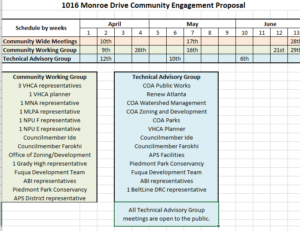
Following the community engagement process, the development team will go through the formal rezoning process. The process is outlined below.
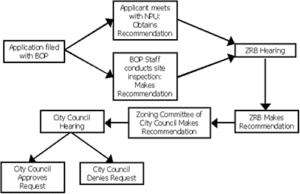
NPU-F requires that rezonings go to the NPU-F Zoning Committee first, then to the neighborhood where the project is located, and then to the full NPU-F meeting.
The following link provides additional information on the City’s website related to zoning changes:
City of Atlanta Zoning Changes
Additional information on the ZRB and Office of Zoning and Development:
Zoning Review Board (ZRB) – This body consists of nine members, appointed by the Mayor and City Council, who meet twice a month to consider property rezonings and special use permits. The Zoning Review Board takes into consideration the recommendations of the relevant Neighborhood Planning Unit and the Office of Planning staff and makes recommendations on rezonings to the Zoning Committee of City Council.
Office of Zoning and Development – This office is responsible for interpreting and enforcing the zoning ordinance. The Zoning Division checks all building permits for compliance with the zoning ordinance and conducts research to verify the zoning classification for a given property.
II. KEY ISSUES RELATED TO THE DEVELOPMENT
There are many critical components with this proposed development. A partial list of the key issues includes:
- Maintaining Single-Family Land Use and Zoning to Prevent “Creep” of Rezoning of Single-Family Land Along Monroe and the BeltLine and elsewhere in the city
This proposed development would require both a land use and zoning change to the parcels that are R4/single family, including the 9 existing single-family homes on Monroe and Cresthill. Any planning ‘logic’ that accepts tearing down single-family homes in one area can be applied just as easily to other areas in Virginia-Highland and along the BeltLine as a whole. If the west side of Monroe and the south side of Cresthill are rezoned, it will set a precedent for rezoning other single-family land in Virginia-Highland and along other parts of the BeltLine. Keeping existing single-family streets (and Monroe itself) as single-family housing is a critical goal. Both VHCA and NPU-F have devoted significant formal planning efforts on these topics in the city’s official plan for the area (the Comprehensive Development Plan, or CDP.) In addition, the BeltLine Subarea Plans says that “protecting existing single family neighborhoods” adjacent to the BeltLine is a critical goal of the BeltLine (see pg. 3/pdf pg. 21).
- Increased Density Designations in the BeltLine Subarea 6 Master Plan and City’s CPD Are Called for In Other Sections Along the BeltLine
Unlike the Kegley/Fuqua land at 10th and Monroe, which has not been designated for increased density in the BeltLine Subarea 6 Plan or any other City plan, increased density has been planned for other parcels along the BeltLine in Virginia-Highland and Morningside. The BeltLine Subarea 6 Master Plan shows the areas along the BeltLine from Ponce to the Interstate (Subarea 6) that have been designated for increased density. The map on pg. 6 shows all of the areas along the Subarea 6 portion of the BeltLine that have land use and zoning already in place to allow for increased density (in Virginia-Highland, it’s the Ponce Place corridor and the area where the storage facility is located on the east side of 10th and Monroe).
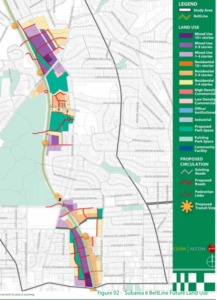
https://BeltLineorg-wpengine.netdna-ssl.com/wp-content/uploads/2012/05/ABI-Subarea-6-Master-Plan.pdf
In addition to the Subarea 6 Master Plan Map, this map shows the land use categories for all of Virginia-Highland:
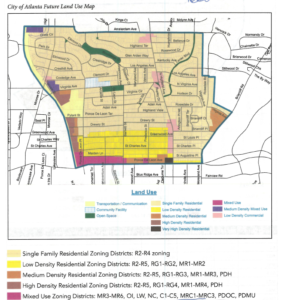
The areas in brown along the BeltLine have been designated for Medium Density and High Density residential. The area in bright yellow has a land use designation of “low density residential” and is zoned “RG-2,” so this area will accommodate increased density without any changes to land use and zoning.
- Affordable Housing Component
The proposal submitted by Kegley/Fuqua to Invest Atlanta includes 30% affordable housing. Not only is affordable housing an important goal and welcomed by VHCA and the City of Atlanta, all rental developments as of January 1, 2018 in the BeltLine overlay district are required to have affordable housing. Key components of affordable housing include the length of the term of the affordable housing and the income level used to measure the affordable cost of the unit. According to the AJC, Invest Atlanta “said it wanted a project that created long-term affordability, in excess of 50 years; the Fuqua plan calls for those affordable units to be available for 15 years, the minimum term.”
In accordance with Atlanta BeltLine policy – reaffirmed again in a meeting with the developer in February, 2018 – affordable housing can be built at the area of 10th and Monroe without removing any existing single-family housing at this or any other site along the BeltLine.
- Traffic and Safety Issues at 10th and Monroe
10th and Monroe is one of the most dangerous intersections in the City of Atlanta. Two people were killed in a single quarter-mile section of the street in Virginia-Highland in the last few years and countless auto accidents have occured in a short half-mile stretch of Monroe. 10th and Monroe serves the BeltLine, Piedmont Park and Grady High School and has significant bike, pedestrian and car traffic. This extraordinarily complicated intersection poses significant challenges; increasing the volume of traffic in all types (pedestrian, cyclist, vehicular) is extremely problematic without significant modifications.
- Adhere to the design principles of the BeltLine Overlay and Redevelopment Plan
The BeltLine Redevelopment Plan states the following:
- “preservation of existing single-family neighborhoods by providing appropriate transitions to higher-density uses” (p. 2)
- “a majority of participants favoring the retention of this site (10th and Monroe) as greenspace” (p. 64)
- “Buildings should also defer to the scale of adjacent single-family neighborhoods by decreasing in height and mass as the proximity increases. A transitional height plane is recommended for all places where new development on the BeltLine approaches existing neighborhoods.” Chapter 6, pg. 13).
- “Buildings should not exceed 52 feet in height within 150 feet of single-family neighborhoods, and should step down in height corresponding to a 45 degree plan extending from 15 feet above the adjacent property line.” (Chapter 7, pg. 16).
The proposed Kegley/Fuqua development contradicts all of these principles.
- Other issues
There are many other issues raised related to this development that were raised at the Community Engagement meeting at Grady High School on April 10, 2018: green space, preservation of trees, route of future transit, capacity issues in the Grady cluster, location of transit stops, overshadowing Piedmont Park and comparison of other land purchases along the BeltLine and surrounding Piedmont Park to name a few.
III. NEXT STEPS
VHCA has been working with a professional planning consultant and a land use/zoning attorney for years on the potential development of 10th Street and Monroe. These professionals have over 40 years combined experience on land use and zoning issues and will be a critical component of challenging the proposed rezoning of single-family land and this out-of-scale development.
VHCA will review these issues and the most effective way to respond to them in a meeting open to all at the Virginia-Highland Church on Thursday, April 19, at 7:00PM. We will provide an update on plans, listen to concerns and alternate approaches and will speak about process, strategy, next steps and how the neighborhood can assist and engage, both financially and in other ways.